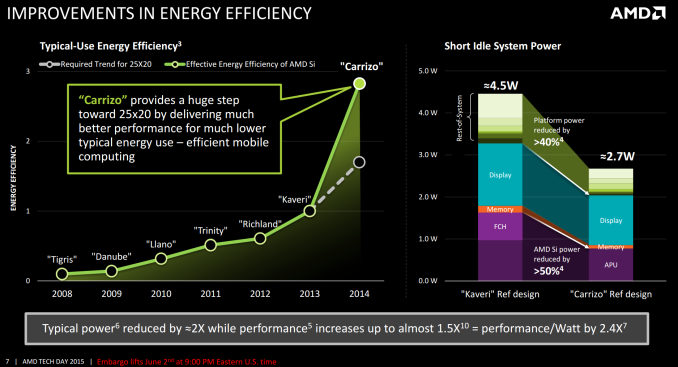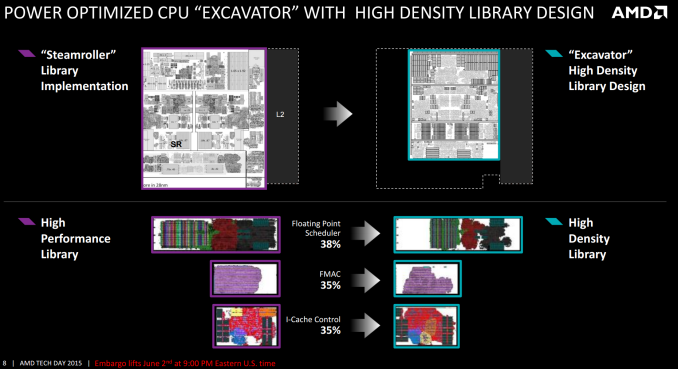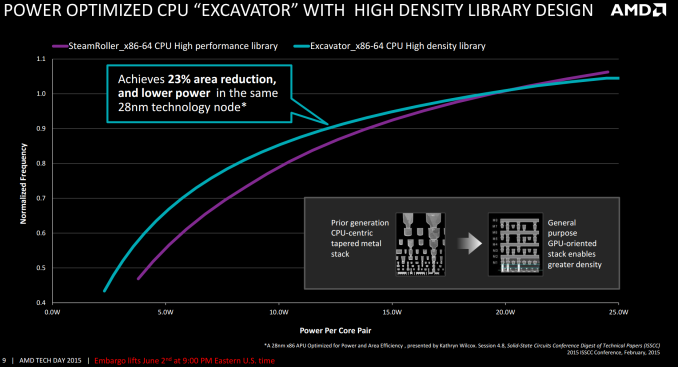AMD Launches Carrizo: The Laptop Leap of Efficiency and Architecture Updates
by Ian Cutress on June 2, 2015 9:00 PM ESTEfficiency and Die Area Savings
AMD’s take home message in all of this is efficiency. We a being quoted a performance per watt increase of 2.4x, coming from typical power draw savings of 2x and performance increase of almost 1.5x for 23% less die area, all in one go.
Ultimately this all helps AMD’s plan to be 25x more efficient with their APUs by 2020, and the cumulative bar chart on the right is how mobile improvements from all sides are being realized. Migrating the southbridge on die severely reduces its idle power consumption to almost zero and can help efficiencies elsewhere in the system. The APU general use and memory controllers are the next targets, but the common constant here is the display. Using a low power display might give battery life in exchange for quality, and there is only so much power you can save at the SoC level. In time, the display will be the main focus of power saving for these devices.
A big part of the reduction in die area comes from the set of high density libraries being used by AMD. Above were three examples provided where >33% gains were made in silicon area. Typically using a high density library design is a double edged sword – it reduces die area and potentially leaves more area for other things, but the caveat is that it may be more prone to defects in construction, require additional latency or have a different frequency/voltage profile. AMD assures us that these changes are at least like-for-like but most of them contain other improvements as well.
It’s worth noting here that AMD has described the high density library project internally as the equivalent of a moonshot, essentially the developers were part of a ‘skunkworks’ division attempting to make drastic changes in order to improve performance. The high density library is one such successful project from that.
With the new libraries, comparing Excavator to Steamroller shows the effect moving designs has. The power/frequency curve below 20W per module shifts to higher frequency/lower power, whereas losses are observed above 20W. However for 15W per module, this means either a 10%+ power reduction at the same frequency or a 5% increase in frequency for the same power. Should AMD release dual thread / single core APUs in the 7.5W region, this is where most of the gains are (as noted in the comments, the dual module designs are at 7.5W per module, meaning that what we should see in devices is already in the peak value for gains and benefits such as 25% frequency or 33% power). As also seen in the insert, the silicon stack has been adjusted to a more general purpose orientation. I could comment that this makes the CPU and GPU work better together, but I have no way of verifying this. AMD states the change in the silicon stack makes production slightly easier but also helps with achieving the higher density Excavator exhibits.













137 Comments
View All Comments
AS118 - Saturday, June 6, 2015 - link
I already signed up on the mailing list that tells you when Laptops with Carrizo come out and are ready to buy. You can do so on AMD's website if you're interested. The H.265 hardware decoding alone interests me, and all the other features like program-specific acceleration and the better GPU performance for mainstream games is nice.If you only play stuff like LoL or Counterstrike, or browser games or even older games on GoG and Steam, the A10 and up look like they'll be quite good.
ivyanev - Sunday, June 7, 2015 - link
As the performance is more than enough for everyday use, and the price is good, using it in mini PC would be great.watzupken - Thursday, June 11, 2015 - link
I was thinking the same thing. If they can produce this for use in those NUC sized PC, I will consider getting one as HTPC if the price is right.Fujikoma - Sunday, June 7, 2015 - link
AMD not including VP9 support is a mistake. They could always drop it if YouTube isn't as popular, but a lot of video in media articles tends to be linked to YouTube.It would be nice to see a die shrink with AMD adding more CPU cores to make up the difference to at least compete with Intel in number crunching.
ivyanev - Tuesday, June 9, 2015 - link
Try using h264ify plugin for chrome - it disables the vp8 and vp9 video, and youtube plays the mp4 versions - butter smooth and efficientfigus77 - Thursday, June 11, 2015 - link
I think everyone should look at APU with respect, apu is the future of pc and notebook, HBM on next AMD GPU will be a start and test for new APU with HBM on chip ram, that will be faster and faster than any ddr4 now available in market and probably any 'on motherboard' ram we will ever see, AMD could start a revolution in PC market, and other will probably copy them in short, even with faster cpu, but IF that will happens we shall be grate to AMD.And sorry for my english...
JDub8 - Tuesday, June 16, 2015 - link
Something I'm always interested in but is never addressed in these articles. The UVD playback and all its magical power savings - what codecs/players support it? If I have a CCCP installed will MPC-HC automaticall benifit? Or will that be reserved for some cyberpower payware dvd/bd player?